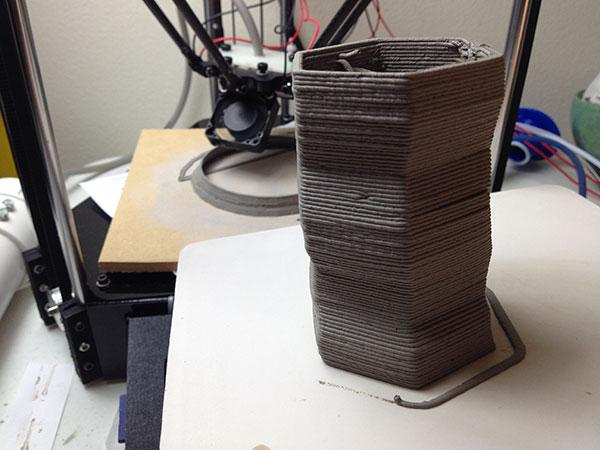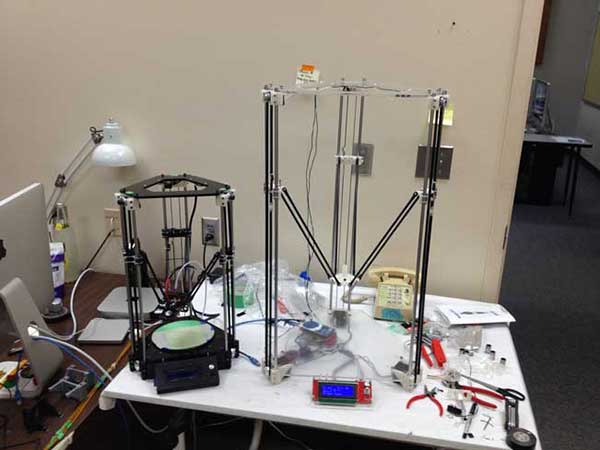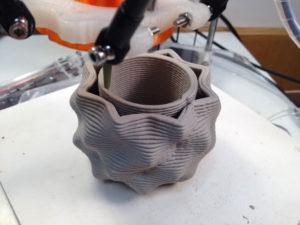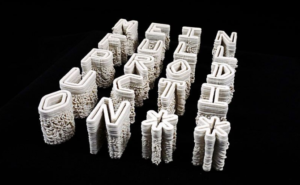With Hard Work, Incredible Patience and Wits, Professor Builds Ceramic 3D Printer from a Simple Delta Kit
Update 10/10/16:
Taekyeom received some advice on his clay extruder and an engineer said, PVC pipe is not a safe material because PVC can crack, or even shatter. Cooper or stainless steel will be good material. DO NOT use PVC piping system for use in compressed air.
 3D printed ceramics are a relatively less-talked-about material in the industry, compared to plastics and metals, for example. But the medium is beginning to develop and become more commonly seen, despite a lot of difficulties inherent in printing ceramic materials. For the most part, clay and ceramic printers tend to be on the industrial, large-scale side of things, with a few exceptions; the complications of the materials mean that they don’t lend themselves particularly well to casual desktop printing.
3D printed ceramics are a relatively less-talked-about material in the industry, compared to plastics and metals, for example. But the medium is beginning to develop and become more commonly seen, despite a lot of difficulties inherent in printing ceramic materials. For the most part, clay and ceramic printers tend to be on the industrial, large-scale side of things, with a few exceptions; the complications of the materials mean that they don’t lend themselves particularly well to casual desktop printing.
That makes the ceramic 3D printer that Taekyeom Lee built even more impressive. Lee, an Assistant Professor of Graphic Design at Appalachian State University, isn’t a traditional sculptor, but his research led him to explore the material and its potential for the development of new fabrication techniques.
“My research explores unconventional methods of creating three-dimensional type with materials and techniques unique to type design — such as ceramics and desktop 3D printing,” he tells us. “This research reflects on the development of the digital fabrication and the unconventional typographic practices in the post-digital age.”
In 2014, Lee began painstakingly handcrafting modular type, using plaster molds to cast the ceramic pieces one at a time. The following year, he began exploring the possibility of combining ceramic production with 3D printing – particularly desktop 3D printing, because of its capacity for production without requiring a full studio. A fan of RepRap 3D printers, Lee purchased a DIY delta printer kit and began modifying it to work with clay.
Once he had assembled the basic printer, he designed a clay extruder. His first attempt involved glue dispensers, but they weren’t too effective, so he moved on to PVC pipe. (Please note that due to safety issues, as PVC can crack or shatter, this type of pipe should NOT be used to build a pneumatic clay extruder. Lee used PVC pipe in prototyping his design, but this material should not be used in this capacity for extrusion.)
“The trickiest part was making it airtight and resists higher psi up to 80 psi,” Lee says. “The pipe says it could resist up to 330psi. But I have not tested higher than 95psi. I made a couple of prototypes using PVC pipe and the 4th version was working properly. Although I made a good clay extruder, it was not still easy to print clay. It required several test print to find right psi and slicing configurations. Although early works were not great, I was very excited to make new ceramic objects.”
Once he had worked out the kinks with the clay extruder, Lee wanted to move on to a printer that could produce larger ceramic parts. He used his first printer to print out parts for the new, bigger version, and ordered the external components such as Arduino, steel shafts and motors. A laser cutter and a sheet of plexiglass finished off the printer’s structure, but the difficult part was getting the printer to run properly. Lee couldn’t figure out how to calibrate the printer without problems, but that didn’t discourage him.
Thus followed an arduous process involving lots of Googling and trial and error as Lee taught himself about firmware. He tested more than 40 different types of firmware before he found one that worked for his printer; the payoff came on October 25, 2015 when he finally managed to calibrate the machine and get it up and running. He tested its capabilities with a pen and paper first, as his ultimate goal involved 3D printed typography. The first word he wrote was “Hi.”
“I have been studied graphic design more than 10 years and do not major in ceramics or engineering. Although I have some knowledge on ceramics and coding, it was not enough,” says Lee (sic). “Definitely, it takes time to teach myself how to build my own 3D printer and clay extruder. However, I am a natural-born maker and good at tedious jobs. I begin with an ambitious idea and willing to deal with endless troubleshooting. I made a prototype with an idea, tested the prototype, documented the result, and make another prototype like other designers who highly value the power of the design process. In order to resolve problems, I need to learn through making and document the progress. I learn something from very failure and success.”
Once the printer was working smoothly, Lee then had to deal with the clay, which presented just as much of a challenge. Finding the right viscosity was tricky: if the clay was too solid, it wouldn’t pass through the extruder, while if it was too soft, it was likely to collapse during the printing process. His solution was to install three 120mm fans, which blow air over the printing bed and dry the soft clay enough to keep it from collapsing while printing. It’s not a perfect solution, and Lee is still working on creating a better one, but even the failed prints offer their own benefits, he says.
“Even for now, I appreciate the collapsed prints and misprints since they leave some comments on the promise of digital fabrication,” states Lee. “Also, I print something and drop to make some interesting shapes – I call it collaboration with gravity – since nonlinear behavior of clay could be a form of arts.”
The clay printer is a continual work in progress. Since his original extruder wasn’t capable of producing complex shapes, Lee studied the example of glue-dispensing companies, who he says use auger valves to control the extrusion of the paste. Using Rhino, he designed his own auger screws and housings, printed them out and began testing them in an exhausting process; in three weeks’ time, he has tested 56 screws and 8 different housings.
He’s still working to find the ideal combination, but in the meantime, his clay prints have grown in complexity and intricacy. His main focus is still on producing new forms of three-dimensional typography, but he’s also printed some beautiful pots and sculptures using a wide variety of clay, including earthenware, stoneware, white clay, porcelain, and even copper clay. While the properties of each type of clay are similar, they have different shrinkage rates, meaning that each needs to be fired at a different temperature – when it comes to the work involved in post-processing, clay as a printing material has all others beat.
Lee’s work has recently attracted the attention of several major media outlets including New York Magazine, INSIDER art and even the Weather Channel, all of which have featured videos of his printing process. The attention is well-deserved; it’s amazing that someone who knew nothing about building 3D printers was able, through exhaustive research and work, to create one that not only functions but produces gorgeous pieces from a difficult material. You can learn more about Lee’s research and work at his website. Discuss this topic further over in the 3D Clay Printer forum thread at 3DPB.com.
Subscribe to Our Email Newsletter
Stay up-to-date on all the latest news from the 3D printing industry and receive information and offers from third party vendors.
You May Also Like
3D Printing News Briefs, April 27, 2024: Research, Digital Dentistry, Cycling, & More
We’re starting today’s 3D Printing News Briefs with some research into 3D printed luminescent quantum-dot polymer architectures and free-form laser beam shaping, and then on to an open source 4-axis...
HP & INDO-MIM Collaborate to Boost Metal 3D Printing in India
HP Inc. and INDO-MIM, a US- and India-based supplier of metal injection molding (MIM) powders and contract manufacturer, have announced that the two companies will collaborate to accelerate additive manufacturing...
3D Printing News Briefs, February 17, 2024: Shot Blasting, Service Bureaus, & More
In today’s 3D Printing News Briefs, we’re starting out with post-processing, as SKZ Würzburg is using a shot blast system from AM Solutions for its research. Moving on to business,...
3D Printing News Unpeeled: Not That Kind of Organ 3D Printing
GKN Aerospace will create a 150 jobs in Trollhattan Sweden with an investment of $60 million part of which comes from the Swedish Energy Agency’s Industriklivet initiative. The investment will...




































